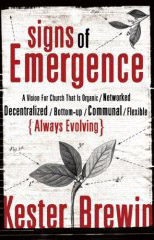
I have been looking forward to reading Kester Brewin’s Signs of Emergence for a long time. The subtitle alone made me excited to see what he had to say: “A Vision for a Church that is Organic / Networked / Decentralized / Bottom-up / Communal / Flexible / Always Evolving.” When I look at my copy of the book right now, I notice there are close to 20 little colored flags marking pages where I thought Brewin had something worth noting – just to give you a sense of the “stickiness” of the book. It’s one that I plan on coming back to and hopefully using sometime this year for a paper I’m working on. There is some great stuff.
The UK edition of this book was called “The Complex Christ” which was an apt title as Brewin places his vision for this new Emergent Church between two sections which are meditations on Christ and the incarnation. Going through various implications of Christ’s incarnation and emergence into the world, Brewin comes up with his vision for the Emergent Church. Brewin is also a fan of James Fowler and his developmental process in faith highlighted in “The Stages of Faith” – and finds ways to incorporate some of the process that Fowler outlines into his vision as well.
Brewin is writing about the Emergent Church – which he says differs from any church that simply applies the label, emerging church. Brewin writes:
My problem with many of these emerging church projects is that they are still attempting to bring church up-to-date by “trainspotting” some aspect of culture and making church fit it. I want to argue that in the Emergent Church the emphasis will be on being the train, rather than trainspotting: rather than trying to import culture into church and make it “cool,” we need instead to become ‘wombs of the divine’ and completely rebirth the church into a host culture. ((Kester Brewin, “Signs of Emergence” (Grand Rapids, MI: BakerBooks, 2007), 92.))
I am very interested in leadership in the Emergent Church, particularly in a traditional expression of it like presbymergent, and so I found this quote helpful:
“Listen,” God says, “I am doing a new thing. Do you not perceive it?” Complexity theory warns us that we must listen because old-order top-down systems cannot survive in an emerging, evolving world. There will be no more revolution, only evolution. As the New York Times proclaimed, this “isn’t just a fascinating quirk of science; it’s the future”…We must reestablish ourselves as the body of Christ, not the machine of Christ. Bodies are organic, dynamic, sentient, and conscious…Machines break down, while bodies evolve. ((Ibid., 85.))
What will those of us who are seeking to remain in “institutions” do with our “old-order top-down” systems – can we change them from within? But doesn’t that imply that we will have to “give in” to those institutions, to get into the right positions of power so that we can make some of these changes? It all seems like a bit of a Catch-22.
In chapter 4, Brewin discusses “The Character of the Emergent Church.” I found the various characteristics that he listed to be very helpful – both for my own understanding and for helping people become familiar with what the Emergent Church is working toward. He takes various characteristics of emergent systems theory and applies it to the church:
- Emergent systems are open systems: open boundaries between the life and work of the church – and of the local community;
- Emergent systems are adaptable systems: churches need to be completely adaptable to their unique, local contexts;
- Emergent systems are learning systems: the church needs to be open to new ways of learning, failing, practicing, getting feedback and strive to be continually seeking to learn – dynamic, not static;
- Emergent systems have distributed knowledge: knowledge does not lie within one person, but is mediated through many people in our collaborative culure – the idea of open source is very important here;
- Emerging systems model servant leadership: leaders will play more “back stage” roles – they will not be on the big screen on the stage;
- Summary: The Emergent Church Must Exist at the Edge of Chaos: “We have seen that emergent systems only evolve in the strange places between anarchy and rigidity, and that specifically they begin to emerge only when they are held at the ‘edge of chaos.'” ((Ibid., 116))
If you’re looking for a good, basic introduction to Emergent and particularly if you’re interested in emergence theory, I’d say that Signs of Emergence would be a very helpful.